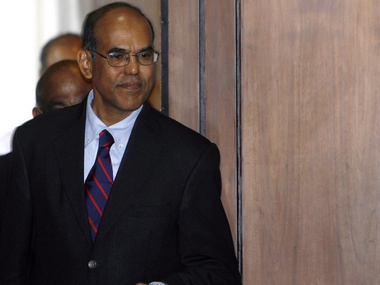The 25 basis points increase in the repo rate by Reserve Bank Governor Duvvuri Subbarao on Tuesday is a politico-economic compromise.
Combined with his “guidance” that rate hikes are now likely to be paused, especially from the December review, it means that the RBI is effectively risking the loss of its anti-inflationary credentials in the hope that falling growth will anyway reduce demand and contain prices.
This can work only if two other factors kick in to contain demand pressures: the government acts decisively on the fiscal deficit front either by reining in spending on subsidies or by raising taxes, or both; and global growth and commodity inflation slow down, easing imported inflation.
[caption id=“attachment_116534” align=“alignleft” width=“380” caption=“Duvvuri Subbarao. Reuters”]  [/caption]
Pranab Mukherjee will have to deliver his part of the bargain for the promised pause in rates. What we don’t know is whether he will do it ( raise taxes, that is) before the budget in February or earlier . The spending cuts can, of course, happen this year itself. But cutting the wrong kind of spending - capital investment - will end up worsening the growth scenario that Subbarao is now trying to rescue.
Did last week’s meeting between Prime Minister Manmohan Singh, Subbarao, Planning Commission chief Montek Singh Ahluwalia, and the PM’s Economic Advisory Council Chairman C Rangarajan, yield a new compromise where the fiscal side will take up some of the burden of handling inflation? Or did Subbarao simply succumb to political pressure from the PMO to moderate his stance before further political damage is done by falling growth and investment? The Economic Times quoted the PM as saying that “the purpose of that meeting was to explore ways and means of how we can bring about a moderation in the rate of inflation.”
Whatever the answer, Subbarao is clearly taking a gamble with inflation. Given that food inflation is already in double-digits and wholesale prices index (WPI) inflation is just under 10 percent, he needed to maintain his hawkish stance.
But he has, instead, opted for a fudge. What he has effectively done is to raise rates by the expected 25 basis points this time (100 basis points make 1 percent), and then made a dove-like promise that this may well be the last of the rate hikes. He has predicted that inflation will start falling from December, and will reach 7 percent by March.
Clearly, the balance of monetary policy is shifting away from worries over inflation to concerns about slowing growth. Subbarao is now lowering his GDP growth forecast to 7.6 percent his year, and this is what has shaken his faith in retaining a singular focus on inflation.
In his eyeball-to-eyeball with the finance ministry over monetary policy, Subbarao has blinked. He has now bought, at least partly, their line that raising rates is more of a risk than not raising it.
But the statements of the governor do not indicate a convincing shift in Subbarao’s stand. For even while indicating a pause in rate hikes, he has done other things to make money costlier for banks.
A key reform measure is the partial deregulation of savings rates. What Subbarao has done is ask banks to create a two-tier savings rate regime where there is a fixed rate for deposits upto Rs 1 lakh, and a variable one for deposits above Rs 1 lakh. This rate, of course, could be higher or even lower than the basic savings rate for deposits upto Rs 1 lakh.
In the short term, given tight liquidity conditions, it is more than likely that savings rates will be raised by many banks - and this is Subbarao’s way of getting banks to raise rates without the RBI having to do it through the policy rate.
Put another way, Subbarao is trying to regain by way of the roundabout the anti-inflationary stance he has bartered away by giving up his hawkish stance.
It is not clear whether Subbarao himself is convinced his policy will work, for he has underlined the risks involved. Apart from the global risks of a meltdown due to the eurozone debt crisis, global commodity prices remain high, food inflation continues to be under pressure in protein-based items like eggs, fish and meat, and the government has announced a higher borrowing programme of Rs 53,000 crore.
The bottomline is that an unconvinced Subbarao has sent mixed signals with his October policy, as his various statements show.
This is how he laid the groundwork for a policy shift from inflation to growth. He said: “Of larger concern is the fact that even with the visible moderation in growth, inflation has persisted. Reassuringly, momentum indicators are turning down, consistent with the Reserve Bank’s projections that inflation rate will decline significantly in December and continue on that trajectory into 2012-13.”
He is saying that since inflation will slow down in future, he is changing his goalposts. In his own words, he now wants to “balance concerns about persistent inflation and moderating growth.”
This is what explains his final guidance: “Notwithstanding current rates of inflation persisting till November (December WPI release), the likelihood of a rate action in the December mid-quarter review is relatively low. Beyond that, if the inflation trajectory conforms to projections, further rate hikes may not be warranted. However, as always, actions will depend on evolving macroeconomic conditions.”
Effectively, Subbarao has gone out on a limb to accommodate the growth-wallahs. Now, it’s all over to Pranab Mukherjee to deliver the fiscal end of the bargain. If he doesn’t, Subbarao would have gambled and lost.


)
)
)
)
)
)
)
)
)



